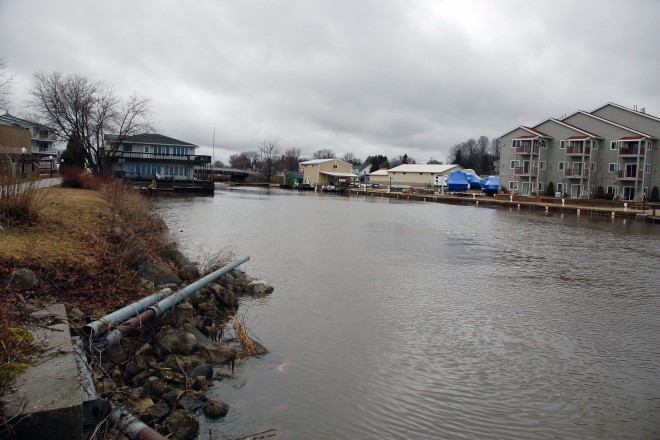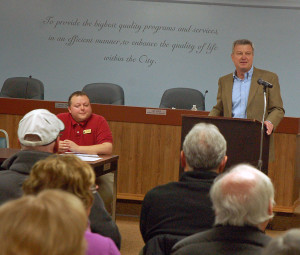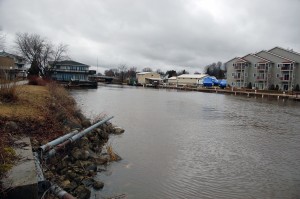Restoring the Ahnapee: Reps Push for River Clean Up
- Share
- Tweet
- Pin
- Share

Republican Assemblyman Scott Krug told Kewaunee County residents to be “loud and active” at an informational session he and Rep. Joel Kitchens held on restoring the Ahnapee River.
A near-capacity crowd filled the Algoma council chambers on March 31 to hear the two legislators talk about what can be done to remove the river from the EPA’s impaired waters list.
Kitchens had asked Krug, of Nekoosa, to talk to residents because he was involved in a successful, citizen-driven effort to clean Lake Petenwell, the second biggest inland lake in the state and part of the Wisconsin River watershed.

“It’s a very big touristy area that depends on the lake for their summer revenues,” Krug said.
But the lake was plagued with regular outbreaks of blue-green algae.
“You could almost walk on the blue-green algae,” Krug said. “It looks like St. Patrick’s Day every day where I live.”
Residents began asking what the state could do to help. That’s when a key tool with an acronym was invoked – TMDL, or Total Maximum Daily Load.
An impaired body of water is monitored and pollution data collected over a certain amount of time to determine all sources of pollution to the water body. A TMDL is then developed, according to the DNR, “as the amount of pollutant that the water body can assimilate and not exceed water quality standards.”
Krug said beginning in 2009 a five-year study was conducted of the Wisconsin River basin, with citizens doing much of the data collection. This study helped identify pollution sources, which included paper factories and other manufacturers, as well as farms.
“But the Legislature never put money into analysis,” Krug said. “After the study was done, it sat on a shelf.”
Krug said he helped to get $230,000 budgeted to analyze the results of the five-year study, and in the past session there was money in the budget to implement whatever is needed to clean the water.
“It’s not going to change overnight,” Krug warned. “It takes quite a while. That’s the frustrating part of government and government programs.”

The mouth of the Ahnapee River in Algoma. Rep. Joel Kitchens is hoping to get the attention of his colleagues in the Wisconsin Legislature to address the river’s impaired status. Photo by Jim Lundstrom.
Krug also warned that Kewaunee County residents are not alone in their frustration with impaired waters. There were 1,695 waterways on the DNR’s 2016 list of the state’s impaired waters.
“A lot, if not most of the lakes in Wisconsin, have that problem,” he said. “So it’s a big challenge. Politically, the challenge is to be active. Focus efforts on being active. It’s not just waiting for the DNR. It’s being active, involved and loud.”
Legislatively, both Krug and Kitchens said getting the Ahnapee higher up on the impaired list will be their challenge.
Kitchens pointed out that “these issues don’t play well with legislators from other areas who don’t see a problem.”
Krug said the local citizens group – PACRS, which stands for Petenwell and Castle Rock Stewards – took legislators on pontoons into Lake Petenwell to see the problem firsthand.
Kitchens said he would work on bringing some legislative colleagues to Algoma.
“You get a lot more support that way when they can actually see the problem,” he said, adding that one of his priorities for the next state budget is to include a TMDL study for the Ahnapee River.
“We’ll start laying the groundwork for it,” he said.
One audience member asked how they can expect the DNR to conduct a study when their science staff took such a hit in the last state budget.
“We were able to head off some of the cuts, from 26 scientists to just eight,” Krug said. “They’re still there, still doing this work, still active, still involved.”
He then added, “I can tell you for certain Gov. Walker is aware of these issues statewide. It’s going to come out in the state budget.”
Lee Luft, a member of the Kewaunee County board and chair of the Kewaunee County Groundwater Task Force, said area residents are less concerned about DNR staffing and more concerned about the DNR’s “complete indifference.”
“Every single CAFO expansion put in front of the DNR is approved at the level asked for by the CAFO,” Luft said, adding that the DNR apparently has no concern for the cumulative effect of its actions.
“We cannot wait five years for a study to confirm what we know, and that is we have too much manure for too few spreadable acres,” Luft said.
Krug said there is only one way to make headway on restoring the river, and that is to go through the TMDL study.
“You have to let the process work,” he said, adding that, “Wisconsin is a generation behind on this.” He cited Michigan as a state that is far ahead of Wisconsin in mitigating impaired waters.
“We could go on for hours on the groundwater issue,” Kitchens said. “I hate to get off on that right now, about how many cows should be in Kewaunee County.”
However, he added there is a very good chance the state Legislative Council will decide to look at Kitchens’ proposal for a study of groundwater protection in the karst region of Door and Kewaunee counties.
“That’s a big deal and it looks very promising,” he said. “We’ll have requirements – you need this much good land for this many cows.”
Krug reminded the audience that for policymakers, “the mantra’s always going to be for them America’s Dairyland. There’s always a focus on ag. We get as big of chunks of policy as we can. You’re not going to see the cow population go down from 99,000 to 10. That’s not going to happen. No governor is going to say, ‘Dairy, go away!’”
Several people pointed out that citizens have been monitoring water in the county for some time and no one seems to take the data seriously.
“If they’re not responding, go to us,” Krug said. “That’s our job. We’ll make them respond.”
Kitchens added that he would get in touch with the right person at the DNR for submitting data.
Reiterating that CAFOs are not going away, Krug advised residents to build coalitions with other regional, state and national organizations.

